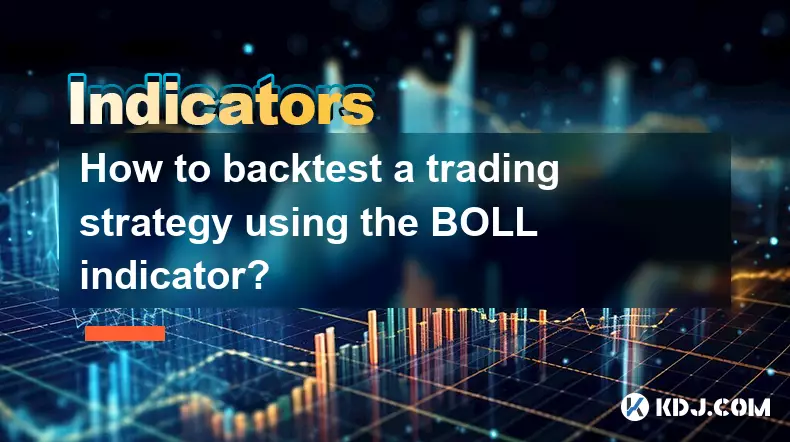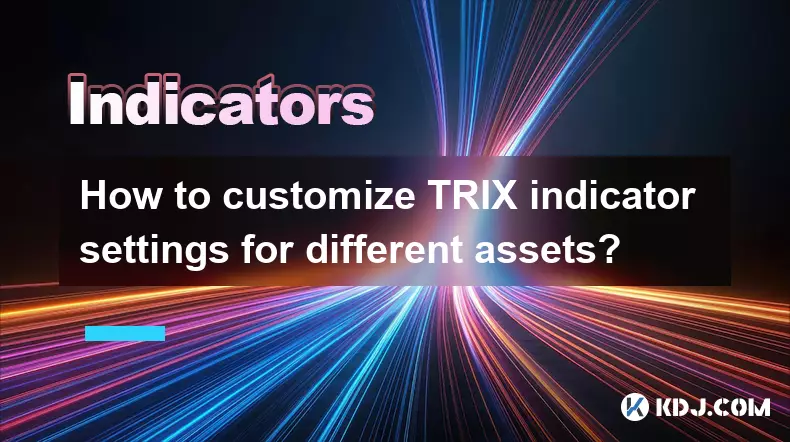-
 bitcoin
bitcoin $102877.190955 USD
1.88% -
 ethereum
ethereum $3430.435064 USD
4.52% -
 tether
tether $0.999264 USD
-0.05% -
 xrp
xrp $2.307310 USD
4.49% -
 bnb
bnb $987.740692 USD
3.82% -
 solana
solana $161.947760 USD
3.97% -
 usd-coin
usd-coin $0.999712 USD
-0.05% -
 tron
tron $0.292810 USD
2.93% -
 dogecoin
dogecoin $0.179738 USD
10.70% -
 cardano
cardano $0.580716 USD
8.75% -
 hyperliquid
hyperliquid $42.463448 USD
8.40% -
 chainlink
chainlink $15.763437 USD
7.05% -
 zcash
zcash $649.595636 USD
17.21% -
 bitcoin-cash
bitcoin-cash $511.610261 USD
7.19% -
 stellar
stellar $0.292537 USD
7.91%
How to backtest a trading strategy using the BOLL indicator?
Bollinger Bands help traders gauge volatility and reversals in crypto markets, with band squeezes signaling potential breakouts and overbought/oversold conditions at the upper/lower bands.
Nov 06, 2025 at 12:04 pm

Understanding the BOLL Indicator in Trading
1. The BOLL indicator, also known as Bollinger Bands, consists of three lines: a middle band (typically a 20-day simple moving average), an upper band, and a lower band (both calculated using standard deviations from the middle band).
- Traders use Bollinger Bands to identify volatility and potential price reversals by observing how prices interact with the bands.
- When prices touch or cross the upper band, it may signal overbought conditions; when they touch or fall below the lower band, oversold conditions might be indicated.
- Squeezes in the bands—when the upper and lower bands come close together—often precede periods of high volatility.
- The indicator adapts dynamically to market changes, making it useful across various timeframes and assets within the cryptocurrency space.
Steps to Backtest a Strategy Using BOLL
1. Define your entry and exit rules clearly—for example, buy when price closes below the lower band and sell when it crosses above the middle band.
- Choose a historical dataset that includes sufficient candlestick data for the crypto asset you're analyzing, ensuring it covers different market phases like bull, bear, and sideways movements.
- Use backtesting software or platforms such as TradingView, MetaTrader, or custom Python scripts with libraries like Pandas and NumPy to simulate trades based on your BOLL strategy.
- Input parameters including the lookback period (usually 20) and the number of standard deviations (commonly 2) used in the BOLL calculation.
- Run the simulation and record key performance metrics such as win rate, profit factor, maximum drawdown, and Sharpe ratio to assess viability.
Common Pitfalls in BOLL-Based Backtesting
1. Overfitting occurs when parameters are excessively tuned to past data, leading to strong historical results but poor live performance.
- Ignoring slippage and transaction fees can inflate profitability estimates, especially in volatile crypto markets where spreads widen.
- Relying solely on BOLL without confirmation from volume or other indicators may result in false signals during low-liquidity periods.
- Survivorship bias arises if backtests use only currently listed coins, excluding those delisted due to failure, which skews results upward.
- Look-ahead bias happens when future data is accidentally included in the test, such as using final closing prices before they were available.
Optimizing BOLL Strategies for Crypto Markets
1. Combine BOLL with volume oscillators like OBV or VWAP to filter out weak breakouts and confirm momentum shifts.
- Adjust band sensitivity based on market regime—wider deviations in high-volatility environments, tighter ones in consolidation phases.
- Incorporate time-of-day filters, recognizing that crypto markets operate 24/7 but often exhibit stronger trends during major trading sessions.
- Test multiple cryptocurrencies rather than focusing on a single asset to evaluate robustness across diverse market behaviors.
- Always validate backtest outcomes with out-of-sample data to ensure the strategy performs beyond the training period.
Frequently Asked Questions
What data frequency works best for BOLL backtesting in crypto?Minute-level or hourly candles are commonly used. Lower timeframes increase trade frequency but also noise, while daily charts reduce signals but improve reliability.
Can BOLL strategies work in ranging versus trending crypto markets?BOLL excels in range-bound markets where prices bounce between bands. In strong trends, prices may ride along one band, triggering premature reversals. Adjusting strategy logic per regime improves results.
Is it necessary to use Python for accurate BOLL backtesting?Not necessarily. Platforms like TradingView offer built-in strategy testers with visual feedback. However, Python allows deeper customization and access to extensive historical datasets via APIs.
How do I account for exchange-specific issues in backtesting?Include realistic assumptions about API latency, order execution speed, and available liquidity. Some backtesting engines allow modeling partial fills and rejected orders common in fast-moving crypto markets.
Disclaimer:info@kdj.com
The information provided is not trading advice. kdj.com does not assume any responsibility for any investments made based on the information provided in this article. Cryptocurrencies are highly volatile and it is highly recommended that you invest with caution after thorough research!
If you believe that the content used on this website infringes your copyright, please contact us immediately (info@kdj.com) and we will delete it promptly.
- BlockDAG, Avalanche, Dogecoin: Crypto's Leading Trio in 2025
- 2025-11-07 22:05:01
- Layer 2 Coins: Will There Be a Potential Explosion by 2026?
- 2025-11-07 16:50:02
- Filecoin, ICP, and the AI Infrastructure Renaissance: Is History Repeating?
- 2025-11-07 16:50:02
- Bitcoin's Wild Ride: Surges, Zeros, and the Search for Stability
- 2025-11-07 17:05:01
- XRP, Bitcoin, and the Rally: What's the Deal, New York?
- 2025-11-07 17:25:01
- Filecoin, DePIN, and a Technical Breakout: What's the Buzz?
- 2025-11-07 17:05:01
Related knowledge

How do professional traders use the TRIX indicator?
Nov 06,2025 at 04:40pm
Understanding the TRIX Indicator in Crypto TradingThe TRIX (Triple Exponential Average) indicator is a momentum oscillator used by professional trader...

Can I use the TRIX indicator on my mobile trading app?
Nov 07,2025 at 07:40pm
The TRIX indicator, a momentum oscillator designed to filter out short-term fluctuations and highlight long-term trends, has become increasingly popul...

How to code a simple TRIX indicator script in Pine Script?
Nov 07,2025 at 06:20am
How to Code a Simple TRIX Indicator in Pine Script The TRIX (Triple Exponential Moving Average) indicator is widely used in cryptocurrency trading to ...

How to trade TRIX indicator signals on the 1-hour chart?
Nov 07,2025 at 05:39am
Bitcoin's Role in Decentralized Finance1. Bitcoin remains the cornerstone of decentralized finance, serving as a benchmark for value and security acro...

Can the TRIX indicator be used for long-term investing?
Nov 06,2025 at 02:19pm
Understanding the TRIX Indicator in Cryptocurrency Markets1. The TRIX (Triple Exponential Average) indicator is a momentum oscillator designed to filt...

How to customize TRIX indicator settings for different assets?
Nov 06,2025 at 03:39pm
Understanding the TRIX Indicator in Cryptocurrency Trading1. The TRIX (Triple Exponential Average) indicator is a momentum oscillator designed to filt...

How do professional traders use the TRIX indicator?
Nov 06,2025 at 04:40pm
Understanding the TRIX Indicator in Crypto TradingThe TRIX (Triple Exponential Average) indicator is a momentum oscillator used by professional trader...

Can I use the TRIX indicator on my mobile trading app?
Nov 07,2025 at 07:40pm
The TRIX indicator, a momentum oscillator designed to filter out short-term fluctuations and highlight long-term trends, has become increasingly popul...

How to code a simple TRIX indicator script in Pine Script?
Nov 07,2025 at 06:20am
How to Code a Simple TRIX Indicator in Pine Script The TRIX (Triple Exponential Moving Average) indicator is widely used in cryptocurrency trading to ...

How to trade TRIX indicator signals on the 1-hour chart?
Nov 07,2025 at 05:39am
Bitcoin's Role in Decentralized Finance1. Bitcoin remains the cornerstone of decentralized finance, serving as a benchmark for value and security acro...

Can the TRIX indicator be used for long-term investing?
Nov 06,2025 at 02:19pm
Understanding the TRIX Indicator in Cryptocurrency Markets1. The TRIX (Triple Exponential Average) indicator is a momentum oscillator designed to filt...

How to customize TRIX indicator settings for different assets?
Nov 06,2025 at 03:39pm
Understanding the TRIX Indicator in Cryptocurrency Trading1. The TRIX (Triple Exponential Average) indicator is a momentum oscillator designed to filt...
See all articles





















![The Graph Price Prediction [GRT Crypto Price News Today] The Graph Price Prediction [GRT Crypto Price News Today]](/uploads/2025/11/07/cryptocurrencies-news/videos/690d4df44fe69_image_500_375.webp)



















































